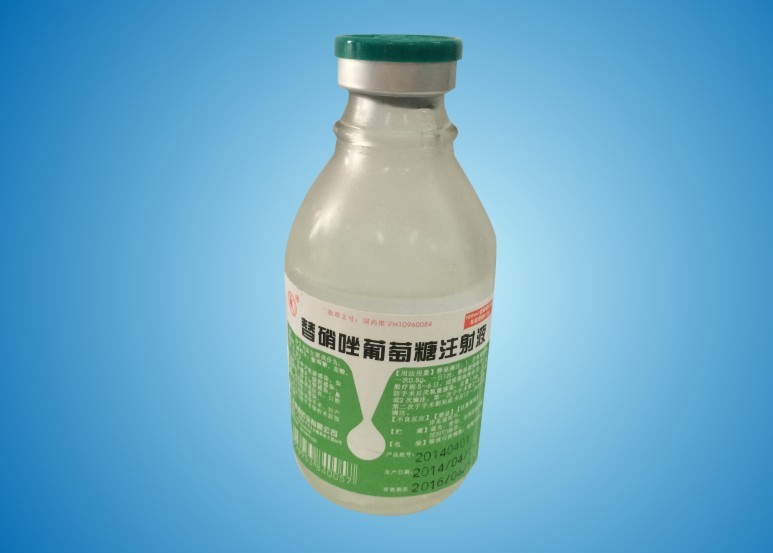
Tinidazole glucose injection
Molecular formula: C8H13N3O4S
Molecular weight: 247.28
Excipients are: glucose, hydrochloric acid.
Category:
Details
Approved date: November 14, 2006
Date of revision: September 30, 2010
November 30, 2015
Tinidazole glucose injection instructions
Please read the instructions carefully and use them under the guidance of a physician.
【Drug Name】
Common name: Tinidazole glucose injection
English name: Tinidazole and Glucose Injection
Pinyin: Tixiaozuo Putaotang Zhusheye
[Ingredients] The main ingredient of this product is: tinidazole. Its chemical name is: 2-methyl-1-[2-(ethylsulfonyl)ethyl]-5-nitro-1H imidazole.
Molecular formula: C8H13N3O4S
Molecular weight: 247.28
Excipients are: glucose, hydrochloric acid.
【Properties】 This product is a clear liquid with no color to yellowish green.
[indications]
1. For a variety of anaerobic infections, such as sepsis, osteomyelitis, abdominal infection, pelvic infection, lung bronchial infection, sinusitis, skin cellulitis, oral infection and postoperative wound infection.
2. Preoperative prophylaxis for colorectal surgery, obstetrics and gynecology surgery and oral surgery.
[Specification] 100ml: tinidazole 0.4g and glucose 5.0g
[Usage and dosage] intravenous drip.
1. Anaerobic infection: 0.8g once a day, intravenous infusion, general course of treatment 5 to 6 days, or according to the condition.
2. Prevention of post-operative anaerobic infection: a total of 1.6g, divided into 1 or 2 infusions, the first time 2 to 4 hours before surgery, the second infusion during surgery or 12 to 24 hours after surgery.
【Adverse reactions】
Adverse reactions are rare and mild, mainly nausea, vomiting, upper abdominal pain, loss of appetite and oral metal taste. There may be headache, dizziness, itchy skin, rash, constipation and general malaise. In addition, there may be angioedema, neutropenia, disulfiram-like reaction and black urine, and occasionally mild phlebitis at the instillation site. High doses can also cause seizures and peripheral neuropathy.
[Contraindications] Disabled for patients with allergies to this product or azoles and active central nervous system diseases and blood diseases.
【Precautions】
1. The infusion rate of this product should be slow. When the concentration is 2mg/ml, the infusion time should be no less than 1 hour. When the concentration is greater than 2mg/ml, the infusion rate should be reduced by 1~2 times. The drug should not come into contact with the aluminum-containing needle and cannula and avoid instillation with other drugs.
2. Carcinogenicity, mutagenic effect: The animal test or in vitro assay found that the product is carcinogenic and mutagenic, but there is still no data in the human body.
3. If the central nervous system adverse reactions occur during the treatment, the drug should be stopped in time.
4. This product can interfere with the test results of alanine aminotransferase, lactate dehydrogenase, triglyceride, hexokinase, etc., and its measured value is reduced to zero.
5. Alcohol-free beverages should not be consumed during medication, because it can cause accumulation of acetaldehyde in the body, interfere with the oxidation process of alcohol, and lead to a disulfiram-like reaction. Patients may have abdominal cramps, nausea, vomiting, headache, facial flushing and the like.
6. Hepatic dysfunction, the metabolism of this product is slowed down, drugs and their metabolites are easy to accumulate in the body, should be reduced, and blood concentration monitoring.
7. This product can be continuously removed from the gastric juice, and some people who place the stomach tube for suction and decompression can cause the blood drug concentration to drop. During hemodialysis, this product and metabolites are quickly removed, so there is no need to reduce the amount of this product.
8. In the case of Candida infection, the symptoms will be aggravated and antifungal treatment should be given at the same time.
9. Before using this product, it should be visually inspected under natural light (avoid direct sunlight). If visible foreign matter is present, it should not be used. If it is found that there are cracks in the bottle mouth, loose seal, gas leakage, discoloration of the solution, turbidity, mildew or cotton-like hyphae, it is strictly prohibited.
10. The osmolality ratio of this product is 0.9 to 1.1.
[Pregnant women and lactating women]
This product can quickly enter the fetal circulation through the placenta. Animal experiments have found that intraperitoneal administration is toxic to the fetus. The effect of this product on the fetus is not sufficient and closely controlled observation, so it should be banned within 3 months of pregnancy. Pregnant women who have more than 3 months are only allowed to use this product when they have a clear indication.
The concentration of this product in milk is similar to the concentration in blood. Animal tests have shown that this product is carcinogenic to young rats, so lactating women should avoid using it. If medication is necessary, breastfeeding should be suspended and breastfeeding should be given after 3 days of withdrawal.
[Child medication] Disabled for patients under 12 years of age.
[Geriatric Use]
Due to liver dysfunction in the elderly, the pharmacokinetics of the product is changed when the product is applied, and the blood drug concentration needs to be monitored.
【medicine interactions】
1. This product can inhibit the metabolism of warfarin and other oral anticoagulants, strengthen their effects, and cause prolonged prothrombin time.
2. When combined with phenytoin, phenobarbital and other drugs that induce liver microsomal enzymes, it can accelerate the metabolism of this product, reduce the blood drug concentration, and slow down the excretion of phenytoin.
3. When combined with cimetidine and other drugs that inhibit liver microsomal enzyme activity, it can slow down the metabolism and excretion of the product in the liver, and prolong the blood elimination half-life (t1/2β) of the product, which should be determined according to the blood concentration. The result is adjusted dose.
4. This product interferes with the metabolism of disulfiram. When the two are combined, the patient may have psychiatric symptoms after drinking alcohol. Therefore, it is not advisable to use this product for disulfiram within 2 weeks.
5. This product can interfere with the determination of serum aminotransferase and lactate dehydrogenase, which can lower the level of cholesterol and triglyceride.
[Drug overdose] is not clear.
【Pharmacology and Toxicology】
This product has high activity against protozoa and anaerobic bacteria. It has antibacterial activity against Bacteroides, Bacillus, Clostridium, Peptococcus, Streptococcus pneumoniae, Vesococcus, and Gardnerella, and the concentration of 2~4mg/L can inhibit most of the anaerobic activity. Oxygen bacteria; microaerobic bacteria, Helicobacter pylori sensitive to it; the MIC of vaginal trichomoniasis is similar to metronidazole, and its metabolites are more active against tinidazole than tinidazole.
The mechanism of action of this product has not been fully elucidated, and the nitroreductase of anaerobic bacteria plays an important role in the energy metabolism of sensitive strains. The nitro group of this product is reduced to a cytotoxicity, which acts on the DNA metabolism process of bacteria and causes the bacteria to die. Drug-resistant bacteria often lack nitroreductase and are resistant to this product. The anti-amyloid mechanism of this product inhibits its redox reaction and breaks the nitrogen chain of the protozoa, thereby killing the protozoa.
【Pharmacokinetics】
The peak concentration (Cmax) of blood samples after intravenous infusion of 0.8g and 1.6g was 14-21mg/L and 32mg/L, respectively. The intravenous administration of 1 g per day can maintain the blood concentration above 8 mg/L.
Tinidazole is widely distributed in the body, and has a high concentration in the reproductive organs, intestinal tract, abdominal muscles, and milk. The concentration in the liver and fat is low, and the concentration in bile and saliva is similar to the blood concentration in the same period. The penetration of the blood-cerebrospinal fluid barrier is higher than that of metronidazole. The concentration of cerebrospinal fluid in the meninges without inflammation is 80% of the blood concentration in the same period, which is related to the higher fat solubility of tinidazole. Tinidazole can pass through the blood placental barrier and can reach high concentrations in the fetus and placenta. The protein binding rate was 12%. In the liver metabolism, about 20% to 25% of the original form is excreted from the urine after intravenous administration. The blood elimination half-life (t1/2β) was 11.6 to 13.3 hours with an average of 12.6 hours.
[Storage] Shading, sealed, and stored in a cool place (not more than 20 ° C).
[Package] Sodium calcium glass infusion bottle, 100ml per bottle.
[Validity Period] 24 months
[Executive Standards] "Chinese Pharmacopoeia" 2015 Edition 2
[Approval No.] National Drug Standard H10960084
【manufacturer】
Company Name: Guangdong Pi Di Pharmaceutical Co., Ltd.
Production address: No. 66, Pidi Avenue, Yueshan Town, Kaiping City, Guangdong Province
Postal code: 529331
Phone number: (0750) 2789348
400-8899-328 (National Service Phone)
Fax number: (0750) 2789348
Website: http://www.pdpharm.com
Keywords:
Tinidazole glucose injection
Prev:
Next:
Online inquiry











